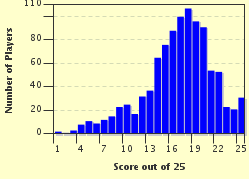Quiz Answer Key and Fun Facts
1. A
Afrikaans, the language spoken by about 10 million people in South Africa, is descended, with slight simplifications, from the language spoken by the European colonists and traders who settled there. Which language is the parent of Afrikaans ("African")?
2. B
With 211 million speakers as a first or second language, this is the world's 7th most-spoken language-- after Mandarin, English, Hindi, Spanish, Russian and Arabic, and ahead of Portuguese, Malay-Indonesian, and French. What is this language from the Indian subcontinent?
3. C
C is for Chinese, but what does that mean? The Chinese government would have you believe that there is a single Chinese language. Linguists would have you believe that that's not the case. Which of these statements about "Chinese" is true?
4. D
In northern Afghanistan, the major language spoken is Dari. You may know Dari better as a variety of another language, widely spoken in the Near East and Central Asia. Which language is this?
5. E
English is one of the world's most widely-spoken languages, yet one of the consonant sounds of English is exceedingly uncommon in the world's languages. Which consonant sound would this be?
6. F
Of what language is it said:
"La langue [...] est une femme. Et cette femme est si belle, si fière, si modeste, si hardie, touchante, voluptueuse, chaste, noble, familière, folle, sage, qu'on l'aime de toute son âme, et qu'on n'est jamais tenté de lui être infidèle."
"The [...] language is a woman. And that woman is so beautiful, so proud, so modest, so bold, so touching, so voluptuous, so chaste, so noble, so familiar, so mad, so wise, that one loves her with all one's soul, and is never tempted to be unfaithful to her."
7. G
The Greek language's most valuable contribution to the rest of the world was surely its alphabet. Now, other civilizations had writing systems and alphabets of various sorts. What made the Greek alphabet different? What gives it its importance in the history of the world's writing systems?
8. H
Soles occidere et redire possunt:
Nobis cum semel occidit brevis lux
Nox est perpetua una dormienda
Suns can set and return again,
For us, when the short light has set once,
There is one eternal night to be slept.
So wrote the Roman poet Catullus in Latin, a language whose light has set and is now sleeping its one eternal night. Most languages are like that. Once they're dead, that's it. One, and only one, language has been successfully revived from the dead to become a widely spoken language once again. Which language is this?
9. The language of Iceland is (surprise, surprise) Icelandic, and it's probably most closely related to Norwegian of all the major modern-day languages. Which of the following is true of the Icelandic language?
10. J
Japanese uses three-- count 'em, three-- writing systems. Which of these is NOT one of them?
11. K
Speakers of which language celebrate "Alphabet Day" every October 9th?
12. L
Lithuanian, Latvian, and Lao share a phonological feature which is common in the world's languages (but strangely absent in English and most European languages). What is it?
13. M
Before the 1800s, only one language was spoken in New Zealand. Since European colonization, the number of speakers has dropped precipitously, and it is now considered an endangered language. The language of which people is this?
14. N
During World War II, these Native Americans served as US Marines in the Pacific, using their own native language as a code the Japanese could never break.
15. O
Henry Wadsworth Longfellow incorporated words from which Native American language in his famous poem, "The Song of Hiawatha"?
16. P
Portuguese seafarers and merchants spread the Portuguese language worldwide. Which of these countries or provinces DOES NOT use Portuguese as an official language?
17. Q
Which Spanish conquistador would have found people speaking Quechua when he came to conquer this empire from the Andes of South America?
18. R
It is impossible to think of Russia without the Russian language, yet one of Russia's most famous rulers did not grow up speaking Russian. Who was this?
19. S
You may think that Sanskrit, the classical Indian language, is as dead as Latin, the stereotypical dead language. That is completely untrue! How could you encounter Sanskrit in modern India?
20. T
This Indian language has inspired unbelievable loyalty from its followers. The Indian government's attempt in 1965 to impose Hindi as the national language provoked extensive rioting and a number of the faithful immolated themselves in protest.
21. U
The language of the Central Asian nation Uzbekistan is, naturally, Uzbek. To which of these better-known languages is Uzbek most closely related?
22. W
Welsh is notorious for its seemingly unpronounceable words, like "llosgwn." How would you pronounce that "ll"?
23. X
X is for Xhosa, a Bantu language from South Africa. What sound does the "Xh" stand for? Come on, it's what makes the language so famous!
24. Y
Yiddish, originally the language of Ashkenazi Jews in Germany, has contributed some memorable vocabulary to the English language. Which of these words originally came from Yiddish?
25. Z
As per our title, Z, of course, stands for Zulu. Is it true that you could hear Zulu spoken in the same country as our other title language, Afrikaans?
Source: Author
pu2-ke-qi-ri
This quiz was reviewed by FunTrivia editor
gtho4 before going online.
Any errors found in FunTrivia content are routinely corrected through our feedback system.

